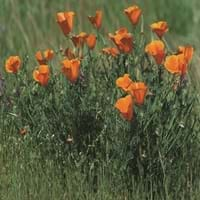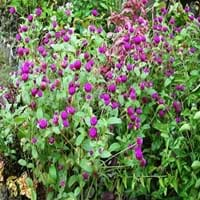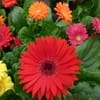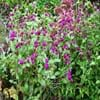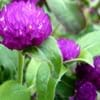Life Span
Perennial
Annual
Type
Tender Perennial
Tender Perennial
Origin
Western United States, Northwestern United States, Southwestern United States, California
Central America
Types
Not Available
Woodcreek Mixed, Buddy Series, Full Series Mixed
Number of Varieties
Not Available
Habitat
Grassland, Open areas
Terrestrial
USDA Hardiness Zone
3-11
9-12
Sunset Zone
H1, 1a, 1b, 2a, 2b, 3a, 3b, 4, 5, 6, 7, 8, 9, 10, 11, 12, 13, 14, 15, 16, 17, 18, 19, 20, 21, 22, 23, 24
A1, A2, A3, H1, H2, 1a, 1b, 2a, 2b, 3a, 3b, 4, 5, 6, 7, 8, 9, 10, 11, 12, 13, 14, 15, 16, 17, 18, 19, 20, 21, 22, 23, 24
Habit
Cushion/Mound-forming
Clump-Forming
Flower Color
Orange, Light Yellow, Lemon yellow, Gold
White, Purple, Pink, Magenta
Flower Color Modifier
Bicolor
Bicolor
Fruit Color
Not Available
Not Available
Leaf Color in Spring
Blue Green
Green
Leaf Color in Summer
Blue Green
Green
Leaf Color in Fall
Blue Green
Green
Leaf Color in Winter
Light Green
Light Green
Leaf Shape
Lobed
Narrow oblong to elliptic
Plant Season
Spring, Summer, Fall
Spring, Summer, Fall
Sunlight
Full Sun
Full Sun
Type of Soil
Loam, Sand
Loam, Sand
The pH of Soil
Neutral
Neutral
Soil Drainage
Well drained
Well drained
Bloom Time
Late Spring, Early Summer, Summer, Late Summer, Early Fall
Early Summer, Summer, Late Summer, Early Fall, Fall, Indeterminate
Tolerances
Drought, Heat Tolerance
Drought
Where to Plant?
Container, Ground
Ground
How to Plant?
Seedlings
Seedlings
Plant Maintenance
Medium
Medium
Watering Requirements
Over-head watering, Requires regular watering
Do Not over Water, Provide sufficient water to saturate the root zone
In Summer
Lots of watering
Lots of watering
In Spring
Moderate
Moderate
In Winter
Average Water
Average Water
Soil pH
Neutral
Acidic, Neutral, Alkaline
Soil Type
Loam, Sand
Loam, Sand
Soil Drainage Capacity
Well drained
Well drained
Sun Exposure
Full Sun
Full Sun
Pruning
Remove damaged leaves, Remove dead branches, Remove dead leaves
Remove damaged leaves, Remove dead branches, Remove dead leaves
Fertilizers
All-Purpose Liquid Fertilizer
14-14-14 Fertilizer
Pests and Diseases
Red blotch
Fungal leaf spots, Gray mold
Plant Tolerance
Drought
Drought
Flower Petal Number
Single
Single
Foliage Texture
Fine
Medium
Foliage Sheen
Matte
Matte
Attracts
Bees, Flying insects
Butterflies
Allergy
Sleepiness
no allergic reactions
Aesthetic Uses
Beautification, Bouquets, Landscape Designing, Showy Purposes
Borders, Showy Purposes
Beauty Benefits
Not Available
Not Available
Environmental Uses
Air purification
Air purification
Medicinal Uses
Arthritis, Bladder Infection, Headache, Insomnia, Liver problems, Menstrual Disorders, Nerve pain, Tooth ache
Antiasthamatic, Antitussive
Part of Plant Used
Flowers, Leaves, Seeds
Flowers
Other Uses
Decoration Purposes, Employed in herbal medicine, Showy Purposes, Used as Ornamental plant
Used in long-lasting leis, Used in making tea
Used As Indoor Plant
Yes
No
Used As Outdoor Plant
Yes
Yes
Garden Design
Alpine, Bedding Plant, Feature Plant, Mixed Border, Rock Garden / Wall, Wildflower
Bedding Plant, Container, Cutflower, Dried Flower/Everlasting, Mixed Border, Wildflower
Botanical Name
ESCHSCHOLZIA californica 'Alba'
GOMPHRENA globosa
Common Name
California Poppy
Globe Amaranth, Globe Flower, Gomphrena
In Hindi
कैलिफोर्निया पोस्ता
Gomphrena
In German
Kalifornien Mohnblume
Gomphrena
In French
pavot de Californie
Gomphrena
In Spanish
amapola de California
Gomphrena
In Greek
Καλιφόρνια παπαρούνας
Gomphrena
In Portuguese
California Poppy
Gomphrena
In Polish
California Poppy
Gomphrena
In Latin
California Poppy
Gomphrena
Phylum
Magnoliophyta
Magnoliophyta
Class
Magnoliopsida
Magnoliopsida
Order
Ranunculales
Caryophyllales
Family
Papaveraceae
Amaranthaceae
Genus
Eschscholzia
Gomphrena
Clade
Angiosperms, Eudicots
Angiosperms, Core eudicots, Eudicots
Tribe
Not Available
Not Available
Subfamily
Not Available
Gomphrenoideae
Number of Species
Not Available
Not Available
Season and Care of California Poppy and Gomphrena
Season and care of California Poppy and Gomphrena is important to know. While considering everything about California Poppy and Gomphrena Care, growing season is an essential factor. California Poppy season is Spring, Summer and Fall and Gomphrena season is Spring, Summer and Fall. The type of soil for California Poppy is Loam, Sand and for Gomphrena is Loam, Sand while the PH of soil for California Poppy is Neutral and for Gomphrena is Neutral.
California Poppy and Gomphrena Physical Information
California Poppy and Gomphrena physical information is very important for comparison. California Poppy height is 15.20 cm and width 15.20 cm whereas Gomphrena height is 30.40 cm and width 30.50 cm. The color specification of California Poppy and Gomphrena are as follows:
California Poppy flower color: Orange, Light Yellow, Lemon yellow and Gold
California Poppy leaf color: Blue Green
Gomphrena flower color: White, Purple, Pink and Magenta
- Gomphrena leaf color: Green
Care of California Poppy and Gomphrena
Care of California Poppy and Gomphrena include pruning, fertilizers, watering etc. California Poppy pruning is done Remove damaged leaves, Remove dead branches and Remove dead leaves and Gomphrena pruning is done Remove damaged leaves, Remove dead branches and Remove dead leaves. In summer California Poppy needs Lots of watering and in winter, it needs Average Water. Whereas, in summer Gomphrena needs Lots of watering and in winter, it needs Average Water.
